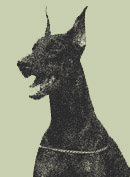Stage I
1-3 weeks (1-20 days) The puppy needs warmth, food, sleep and his mother.
Neurologically very primitive, the puppy responds by reflex and essentially it is unable to learn.
4th week (21-28 days)
The puppy needs its mother most at this time. It is a period of extremely rapid sensory development.
Neurologically the brain is suddenly able to receive messages; the circuits are "turned on".
Weaning should not take place at this time; the puppy is extremely vulnerable.
5th-7th week (29-49 days)
The puppy needs his mother and litter-mates. Dogs removed from the litter at this period tend
to be unable to socialize with other dogs, may fight, refuse to breed, etc.
Contact with humans and gentle training is beneficial and helps the pup set the stage for
more intense contact with humans later on.
7th week (49th-56th day)
This is the ideal time for the puppy to transfer his loyalty to his new owner. Mentally he is able to
learn whatever any adult dog can learn, his being is neurologically complete. However, physically he
will not be able to do the tasks of an adult dog. For example he can't jump one and a half times his height
with the dumbbell in his mouth, but he can learn the exercise if it is scaled down to his size.
Socialization and training should continue on a regular basis. Bonds formed at this time are extremely strong.
8-10 weeks (57-70 days)
This is the fear-imprinting period. Any traumatic experience such as shipping, ear cropping, severe punishment,
etc. may have a lasting effect on the dog. New experiences must be non-fear producing.
Proper training and socialization should continue.
11-16 weeks (71-112 days)
The puppy continues to learn from his experiences. If left with other dogs, he may become imprint only to dogs;
taking his leadership from them and never developing a strong relationship with human beings. Lack of socialization with humans
will result in shy behaviour such as found in wild animals. Lack of exposure to other environments and exploration may result
in "kennel syndrome", where the dog is unable to cope with any change from his routine environment.
Clarence Pfaffenberger was able to put the critical stages of puppy development into practical application in the
breeding program of Guide Dogs for the Blind. He used Scott and Fuller's research and supplemented it with specially
developed puppy tests to pinpoint the potential guide dogs in a litter at approximately 8 weeks of age. Through planned
breeding, careful attention to development, and puppy testing he raised the percentage of successful guide dogs in the breeding
program from 9% to 90%.
An experiment of Clarence Pfaffenberger's for example, demonstrates the importance of early socialization.
After testing the population of 154 puppies who were all trained later for guide work he found: "of the puppies
who had passed their tests and been placed in homes the first week after the conclusion of the tests, ninety percent
became guide dogs; those who were in the kennel more than one week and less than two weeks faired almost but not quite as well;
those left in the kennel more than two weeks but less than three, showed only about 57% guide dogs; of those who were in the kennel
more than three weeks after the tests, only 30% became guide dogs."(The New Knowledge of Dog Behavior)
The break in socialization between testing and placing at this critical point (after 7-8 weeks) resulted in dogs who
could not take the responsibility for a blind master, while their litter mates whose socialization had not been interrupted,
succeeded at the task.
By using Campbell, Pfaffenberger and Working Dogs, the Volhards developed a system for testing puppies which would:
1) indicate the dog's basic temperament traits, and
2) indicate the dog with the most obedience potential. (...)
Ideally, puppies are tested in the 7th week, preferably the 49th day. At 6 weeks or earlier the puppy's
neurological connections are not fully developed. (If the test is conducted between 8-10 weeks, the puppy is in the fear
imprint stage and special care must be taken not to frighten it.)
Also included in the Obedience Aptitude Tests is a section on structure. Over 60 breeds conform to what is called
"conventional body type", that it, 45 degree shoulder layback and 90 degree angulation front and rear.
The greater the deviation from this norm the less efficiently the dog will be able to perform obedience exercises.
Other impediments to efficiently are HD, cowhocks, eastie-westie feet, crossing in front or rear when gaiting.
A simple guide to follow for puppies at this age (7-8 weeks) is "what you see is what you get" notwithstanding the
all-too-familiar assurance "don't worry, he'll grow out of it". Be particularly wary of the statement,
"he's not much of a conformation dog but he'll do fine in obedience." This could mean the dog is perhaps mismarked
or has light eyes, but is structurally sound. However, often it means the dog has a serious structural fault.
This dog will be unable to take the strenuousness of training and competing in the obedience ring.
If you feel that evaluation structure accurately is above your head, seek competent help.
Last but not least, the prospective puppy tester must have a chance to observe the parents of the litter,
preferably both parents but at least the dam. If the sire and/or dam have characteristics which are not desirable
there exists a good chance some, if not all, of the puppies will have inherited these undesirable traits.
The fact that the breeder of my "pick of the litter" puppy warned me not to get my face close to the dam should have
been a tip off to watch for excitability and a tendency to bite in the puppies.
The safest and easiest thing to do when faced with parent dogs of undesirable temperament is simply to look
for another litter of pups whose sire and dam more closely conform to your ideals. If you must have a pup from this
litter pay particular attention to the test scores of the litter and do not select a pup which shows any tendency towards
undesirable traits.
The following is a concise chart explaining each test and the scoring, a sample score sheet and an interpretation of the scores:




